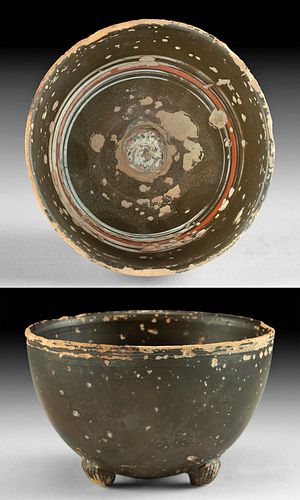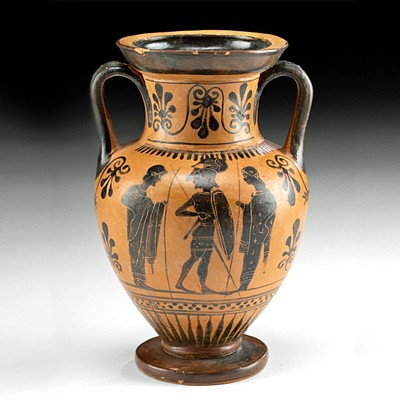Gnathian Bowl w/ Shell Feet, Dionysus Relief Head, TL'd
Lot 40
About Seller
Artemis Fine Arts
686 S Taylor Ave, Ste 106
Louisville, CO 80027
United States
Selling antiquities, ancient and ethnographic art online since 1993, Artemis Gallery specializes in Classical Antiquities (Egyptian, Greek, Roman, Near Eastern), Asian, Pre-Columbian, African / Tribal / Oceanographic art. Our extensive inventory includes pottery, stone, metal, wood, glass and textil...Read more
Categories
Estimate:
$3,000 - $4,500
Absentee vs Live bid
Two ways to bid:
- Leave a max absentee bid and the platform will bid on your behalf up to your maximum bid during the live auction.
- Bid live during the auction and your bids will be submitted real-time to the auctioneer.
Bid Increments
| Price | Bid Increment |
|---|---|
| $0 | $25 |
| $300 | $50 |
| $1,000 | $100 |
| $2,000 | $250 |
| $5,000 | $500 |
| $10,000 | $1,000 |
| $20,000 | $2,500 |
| $50,000 | $5,000 |
| $100,000 | $10,000 |
| $200,000 | $20,000 |
About Auction
By Artemis Fine Arts
Mar 9, 2023
Set Reminder
2023-03-09 10:00:00
2023-03-09 10:00:00
America/New_York
Bidsquare
Bidsquare : Exceptional Ancient, Ethnographic, & Fine Art
https://www.bidsquare.com/auctions/artemis-gallery/exceptional-ancient-ethnographic-fine-art-12354
Artemis Fine Arts info@artemisfinearts.com
Artemis Fine Arts info@artemisfinearts.com
- Lot Description
**First Time At Auction**
Magna Graecia, South Italic Colonies, near present-day Ignazia, ca. 340 to 320 BCE. An impressively rare example of a Gnathian pottery bowl presenting tall walls that rise over a relief head - likely of Dionysus the Greek god of wine - in the central basin, all supported by 3 petite, seashell-shaped feet. Framed by a crown of luscious locks and perhaps an ivy wreath, the deity's youthful visage is displayed in three-quarters position, boasting recessed eyes, round cheeks, and a slender nose. Dionysus - Roman Bacchus - was an appropriately frequent subject for drinking vessels. Just think of the pleasure that as you sip the deity of your beverage is slowly revealed! A truly special example from Magna Graecia! Size: 4" Diameter x 2.5" H (10.2 cm x 6.4 cm)
The interior medallion in high relief and hemispherical profile of this terracotta bowl are derived from metallic prototypes. Clay vessels with these features were meant to resemble these luxury items and began to be produced in the Hellenistic period in a variety of regions, such as Southern Italy, Asia Minor, and mainland Greece. The rich black glaze and red and white applied pigments of this example, however, identifies it as specifically Gnathian.
Gnathia ware is named for the site where it was first discovered - the Apulian site of Egnathia. The black glaze ware is traditionally decorated with floral motifs in red, white, or yellow hues. Scholars believe that its production most likely was centered around Taras, with primary workshops in Egnathia and Canosa. The quantity and quality of Greek colonial Apulian potters increased significantly following the Peloponnesian War when Attic exports dramatically decreased. Apulian artistry demonstrates influences of Ionian (Athenian, Attic) conventions, as well as Doric (western colonial Greek) styles, with a palpable native Italian aesthetic.
A bowl with a similar form, feet, and painting style can be found at the Princeton University Art Museum under object number 1997-470. Another comparable example with the medallion of a bust at the center is located at the Metropolitan Museum of Art under accession number 17.194.2079.
This piece has been tested using thermoluminescence (TL) analysis and has been found to be ancient and of the period stated. A full printed and bound report will accompany the item upon purchase.
PLEASE NOTE: Due to recent increases of shipments being seized by Australian & German customs (even for items with pre-UNESCO provenance), we will no longer ship most antiquities and ancient Chinese art to Australia & Germany. For categories of items that are acceptable to ship to Australia or Germany, please contact us directly or work with your local customs brokerage firm.
Provenance: private Chicopee, Massachusetts, USA collection; ex-East Coast, USA collection, acquired before 2002
All items legal to buy/sell under U.S. Statute covering cultural patrimony Code 2600, CHAPTER 14, and are guaranteed to be as described or your money back.
A Certificate of Authenticity will accompany all winning bids.
We ship worldwide and handle all shipping in-house for your convenience.
#176696Chips, nicks, and abrasions commensurate with age, as shown. Small stable hairline fissure extending down from rim on one side and loss of relief detail on face. Otherwise, good condition and intact with nice remaining pigments. TL holes to underside of base and exterior of rim.Condition
- Shipping Info
-
All shipping is handled in-house for your convenience. Your invoice from Artemis Gallery will include shipping calculation instructions. If in doubt, please inquire BEFORE bidding for estimated shipping costs for individual items.
-
- Buyer's Premium



 EUR
EUR CAD
CAD AUD
AUD GBP
GBP MXN
MXN HKD
HKD CNY
CNY MYR
MYR SEK
SEK SGD
SGD CHF
CHF THB
THB















